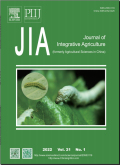首页|期刊导航|农业科学学报(英文)|Grain yield and N uptake of maize in response to increased plant density under reduced water and nitrogen supply conditions
农业科学学报(英文)2024,Vol.23Issue(1):122-140,19.DOI:10.1016/j.jia.2023.05.006
Grain yield and N uptake of maize in response to increased plant density under reduced water and nitrogen supply conditions
Grain yield and N uptake of maize in response to increased plant density under reduced water and nitrogen supply conditions
摘要
关键词
water and N reduction/plant density/maize/grain yield/N uptake/compensation effectKey words
water and N reduction/plant density/maize/grain yield/N uptake/compensation effect引用本文复制引用
Jingui Wei,Qiang Chai,Wen Yin,Hong Fan,Yao Guo,Falong Hu,Zhilong Fan,Qiming Wang..Grain yield and N uptake of maize in response to increased plant density under reduced water and nitrogen supply conditions[J].农业科学学报(英文),2024,23(1):122-140,19.基金项目
We are very grateful for financial support of the National Natural Science Foundation of China(U21A20218 and 32101857),the'Double First-Class'Key Scientific Research Project of Education Department in Gansu Province,China(GSSYLXM-02),the Fuxi Young Talents Fund of Gansu Agricultural University,China(Gaufx-03Y10),and the"Innovation Star"Program of Graduate Students in 2023 of Gansu Province,China(2023CXZX-681). (U21A20218 and 32101857)

